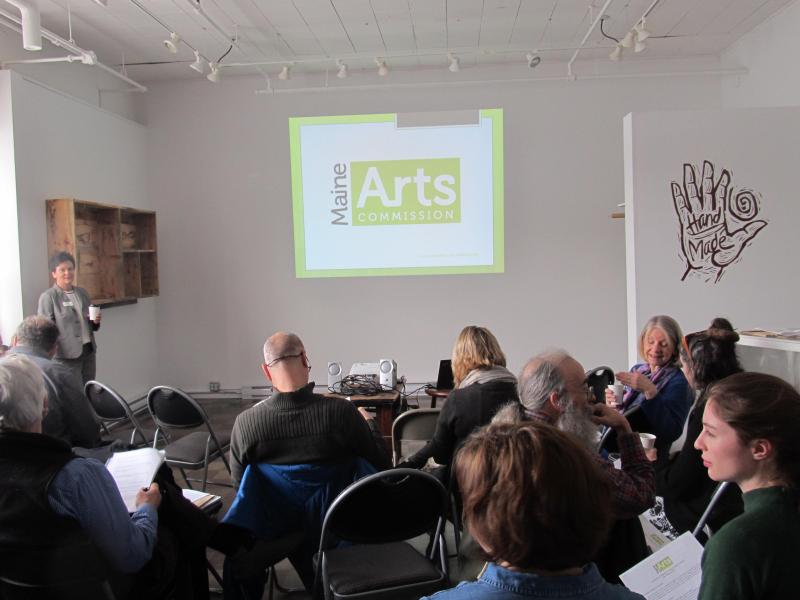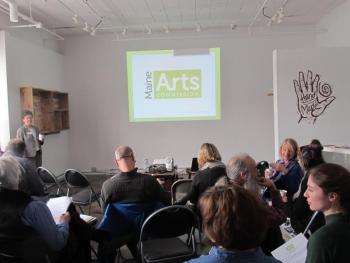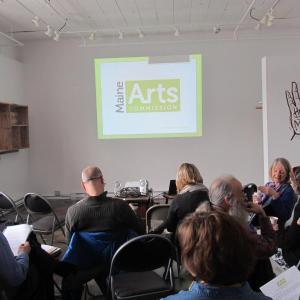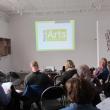Has life for Midcoast artists gotten better or worse in the last 15 years?
 The crowd for the Maine Arts Iditarod, a traveling day-long program from the Maine Arts Commission to examine connections in the creative sector to other sectors. (Photo by Kay Stephens)
The crowd for the Maine Arts Iditarod, a traveling day-long program from the Maine Arts Commission to examine connections in the creative sector to other sectors. (Photo by Kay Stephens)
 The crowd for the Maine Arts Iditarod, a traveling day-long program from the Maine Arts Commission to examine connections in the creative sector to other sectors. (Photo by Kay Stephens)
The crowd for the Maine Arts Iditarod, a traveling day-long program from the Maine Arts Commission to examine connections in the creative sector to other sectors. (Photo by Kay Stephens)
BELFAST — One of the questions Maine Arts Commission Executive Director Julie Richard asked a crowd of about 25 artists at Waterfall Arts last week was “what has changed for better or worse” for Maine artists in the last 15 years? As part of a traveling Maine Arts Iditarod, which hit Belfast on Jan. 26, the first session of the day focused on Connecting Creativity and Cultural Equity in Maine.
Several participants in the audience thought the Midcoast’s strengths included the emergence of a Creative Economy, a resurgence in cultural planning, an increase in technology and digital connections and an interest in globalization.
However, for every positive, there’s a negative, and in the last 15 years, several Midcoast residents said they’ve seen a steep decrease in affordable housing, which makes it extremely difficult for artists inspired by Maine to actually live here. There were multiple arts education teachers in the audience who’d seen drastic cuts in arts education spending in schools, first hand, whereas others expressed the frustration of a bureaucracy that demands more collected data to prove that arts education is beneficial, or “works.”
A special education teacher said, “When you work with kids in this field, you know that art education works. They become better students; they are more excited to learn and become more inclusive with one another.”
Economics, not surprisingly, are still the heart of most artist’s woes. As another audience member put it, “I feel as Mainers, we’ve never quite gotten out of the Great Recession. People are still holding tight to their pocketbooks and with the uncertainty of this administration change, no one knows when the scatological element is going to hit the oscillating blades, you know?”
David Estey, a Belfast artist said, “One of the positives has been the Maine Arts Commission and the whole notion of the Creativity Economy. There have been a lot of advancements in the arts in the last 15 years. In talking to the local businesses, I can tell you that business owners have seen the difference that has made in Belfast — particularly in how much money people have spent on art. In terms of where we are after the last decade, Belfast has enjoyed a reputation for the arts, but now things are shifting a bit, so we’ve got to pay attention to keeping the arts up front and making those connections with businesses.”
Brenda Harrington, Belfast Free Library’s adult programming coordinator, is heavily involved with area artists and writers. She routinely curates from a list of first-time exhibitors to established artists who apply to show their work library’s Barbara Kramer Gallery. She’s also responsible for Maine Writers Talk about.... series.
“There has been an explosion of interest in the arts in the last 10-15 years,” said Harrington. “I have so many artists who come to the library wanting to exhibit in the gallery. But, also in terms of adult programming, it has grown as well, both in interest from the public and in artist/writer participation. But as mentioned in the first session, money is always an issue to support artists. It’s hard to get grant money. We’re all cheerleaders for each other, that’s one thing I’ve noticed.”
Part of the morning session also included some little-known resources from the National Endowment for the Arts, specifically, its Creativity Connects, a three-part-initiative including an infrastructure report, Bright Spots (successful projects across the country where arts and non-arts collaborators work to further common goals, which you can contribute to) and where artists can find information on Artworks Grants.
For more information visit: mainearts.maine.gov
Kay Stephens can be reached at news@penbaypilot.com
Event Date
Address
United States


























